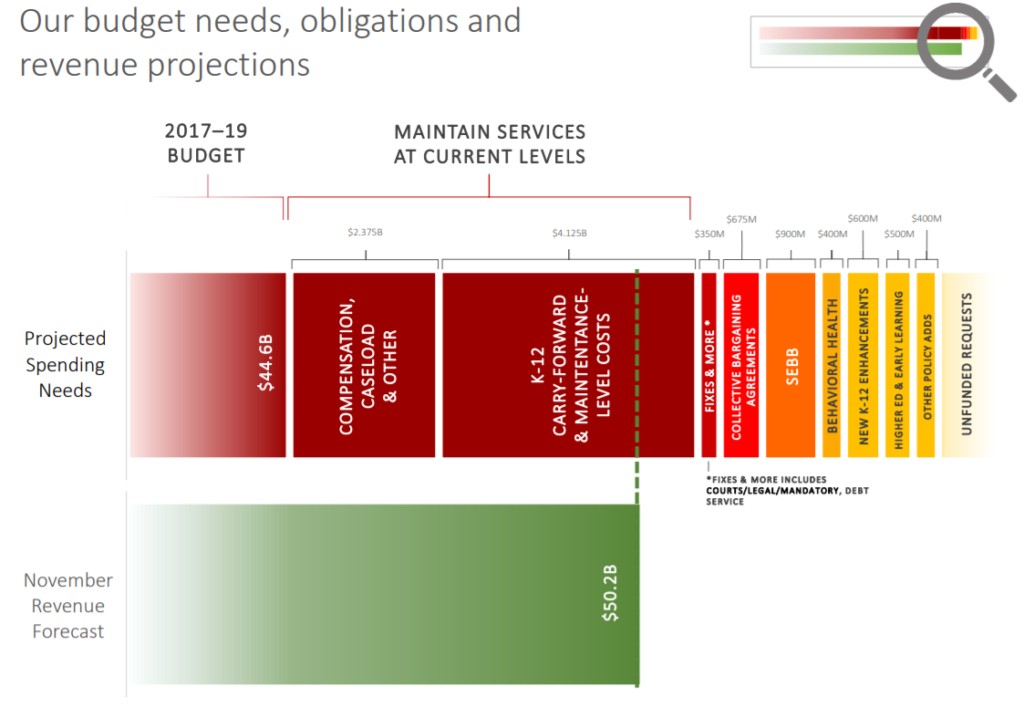9:13 am
January 16, 2019
In an interview on TVW’s “The Impact” Monday, host Mike McClanahan asked Gov. Inslee if he thinks the Legislature will adopt a capital gains tax this session.
I think there’s every prospect of that, for a couple of reasons. One, legislators are gonna confront a reality, and that reality is the kind of things that Washingtonians expect and deserve from their state government simply will not be able to be provided within the existing revenue structure. That’s because there are bow waves from the McCleary decision of $4 billion that has to be financed. I think a lot of people thought the McCleary decision was behind us. Well in fact it’s ahead of us because this is the first year the legislators will need to come up with a full biennium, and that’s $4 billion.
The governor made similar comments at the AP Legislative Preview on Jan. 10. He is right that 2019–21 will be the first biennium in which McCleary will be fully funded for two years (it was fully funded for one year in 2017–19). And he’s right that that spending is the driving force behind the exceptionally large $6.4 billion maintenance level (the cost of continuing current services) for the biennium.
David Schumacher, the director of the Office of Financial Management, spoke to the House Appropriations Committee on Monday about the governor’s budget proposal (video here, presentation here). Referencing Gov. Inslee’s proposed tax increases, which would be on top of the substantial increase in revenues already expected for 2019–21, he said,
Why is $50 billion not enough, and why did maintenance level grow so much this year? There’s about $6 billion of maintenance level growth and usually you would imagine that maybe there’s a billion and a half or 2 billion . . . . The biggest part of the maintenance level growth is fully paying for the McCleary bill from last biennium. It’s about a $4 billion cost. So when we tell each other that McCleary is behind us, we still have to figure out how to get that $4 billion built into the base as we move forward. Without that, then revenues would have been higher than maintenance level and I think there would have been a different discussion about revenues relative to the budget total.
His presentation includes this graphic:

It suggests that the state is not able to cover even maintenance level spending for the biennium. But the chart shows only revenues, not all available resources. The state also has the 2017–19 unrestricted ending fund balance to work with (this amount automatically becomes the beginning fund balance for 2019–21). According to the November outlook, it is estimated to be $1.633 billion. In all, total available resources for 2019–21 are expected to be $51.442 billion. That is enough to cover the maintenance level with $689 million left over. (Schumacher acknowledged, “Now there was money in reserves, so I guess we could have probably balanced at maintenance level in the short run.”)
To be sure, that $689 million doesn’t go very far down the governor’s list of policy additions (and it probably doesn’t go very far down the lists of many, if not most, legislators). But McCleary can be funded with existing resources. Further, although Gov. Inslee is right that McCleary is still a significant factor in the 2019–21 budget, it is not accurate to say that this is a surprise. Indeed, we know both of these things thanks to the four-year balanced budget requirement. The requirement is meant to show the longer-term impacts of policies that phase in over time in order to prevent unsustainable bow wave spending. As a result, the outlook has included the 2019–21 impact of the McCleary spending. This forced legislators to notice it ahead of time, and they passed 2017–19 and 2018 supplemental budgets that balanced over four years.
Categories: Budget , Categories.